FROM THE WELL DRILL TO THE RELAY PASSENGER
2005-2021
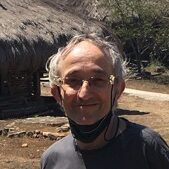
In 2009, Jean-Michel Gallet, an enlightened traveler, passionate about Asia, having heard of André Graff and his work, went to meet him on the island of Sumba.
Following this visit, in a Roadmap entitled “From Alsace to Sumba” he drew up in 2012 an enthusiastic and sincere portrait of the man he describes as “a humanist and environmental activist”.
For all these years, André has remained faithful to this “quest for the Absolute” so well described in the documented text that follows. What defines him the most in my (our?) eyes is his constancy, his will, his courage and his abnegation, despite difficulties of all kinds, disappointments, illnesses. His “faith” also to pursue the goal he has set himself.
At the age when others are retiring, André decides (after too long a stay beyond his control in Europe, in 2020) to leave again, to face the shock of what he will discover in a period of pandemic and typhoons, and to resume operations in Sumba. This time with the idea of enhancing what has already been done and passing the baton to the local populations. On his return, he was pleasantly surprised to see that, in his absence, acquaintances had built wells, using the techniques he had taught them, to irrigate their rice fields. A great introduction to pass the torch.
To remain at the service of underprivileged populations, to improve the lives of women, to allow children to go to school in these unrecognized and forgotten Sunda islands, such is the challenge of this extraordinary character who puts his life at the service of others. For almost 20 years.
Discover the portrait of André Graff by JM Gallet:
Waikabubak, 08/15/2012 – Paris, 11/25/2012

Roadmap 39 – from Alsace to Sumba (Indonesia), the journey of a humanist and environmental activist
Anyone who travels the roads or paths of the island of Sumba (1), one of the most arid of the Indonesian archipelago, constantly encounters children and women transporting from a source or a well, who in a bucket, which in a jerrycan, the precious (2) water. Eliminate this drudgery, thanks to renewable energy, on this deprived island which seems out of time (3), such is the challenge launched by an Alsatian, André Graff, who for seven years has lived in a village in the west coast of the island, Waru Wora (4). After an extraordinary or, at least, atypical career…
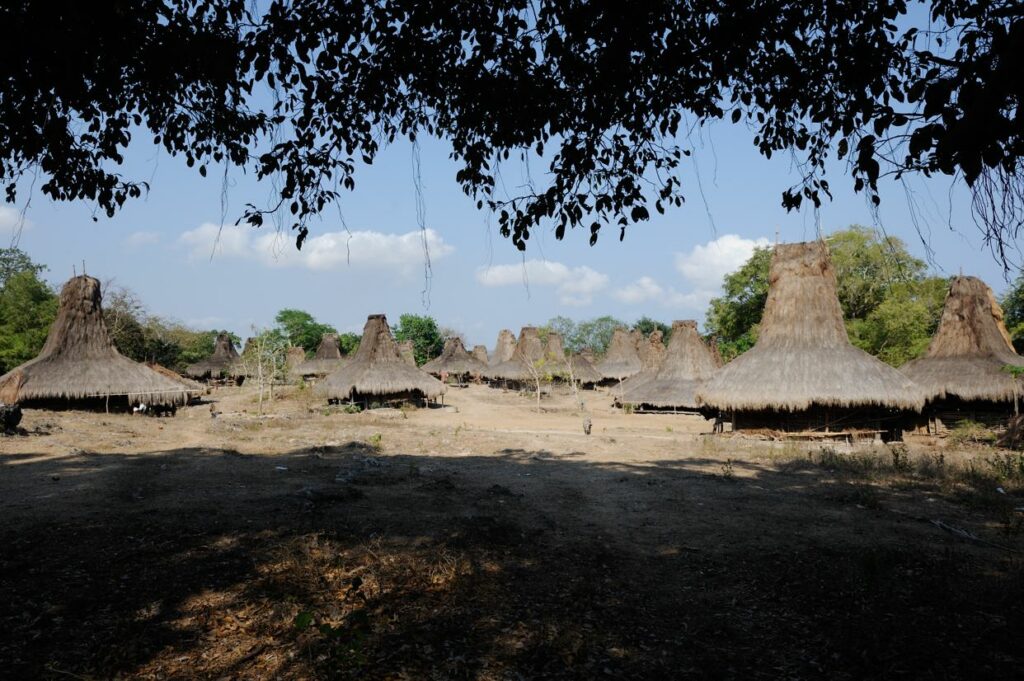

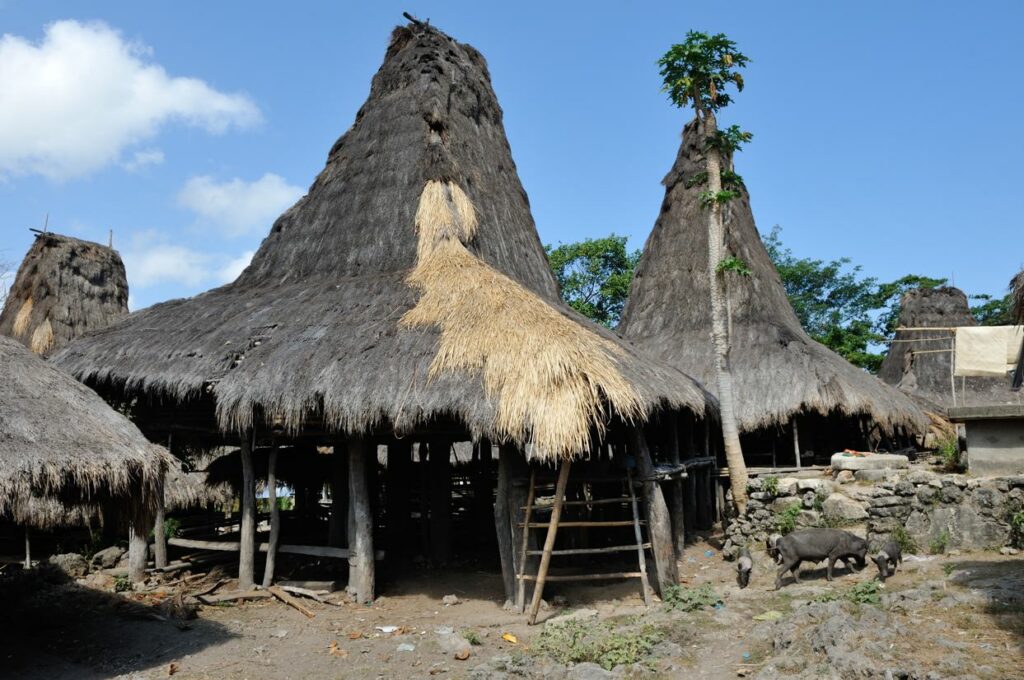

* from Alsace to Sumba
Born 54 years ago in Munster, André Graff had an unusual job for 22 years: hot air balloon pilot. A professional activity which allowed him to discover the world and in particular, in 1990, on his return from a mission in Australia, Indonesia, “an attractive country where I had promised myself to return”. But his job then took him entirely: “an exciting job that I exercised with passion”.
In 2003, borreliosis – or Lyme disease – led him to cease all activity for a year. This respite is an opportunity to take stock and turn a page: “I then decided, even if I didn’t know what I was looking for exactly, to leave my golden cage”. Not without difficulty: “when I made the decision to sell my business -for a symbolic euro-, I locked myself up at home and was depressed for a week”.
In search of a new path, he decides to set out again in the vast world, but this time, taking his time. He hesitates between South America and Asia. It is finally in Indonesia that he finds himself in 2004. Two months go by. Like many travellers, he takes photos and promises to bring back a copy to those of the inhabitants he has fixed on his film. And that’s how, in 2005, he returned to the islands of the Indonesian archipelago. Presumably for a limited time. Time which, however, allows him, in Sumba, to discover the experience of its inhabitants, and especially the alienating daily chore of water as well as the diseases, sometimes fatal, attributable to water unfit for consumption. Chance then brought him to meet, on an island near Sumba, an Austrian missionary, Father Lackner. André Graff is interested in the development work carried out by the religious. The latter builds wells there made of concrete cylinders with a diameter of 1.20 meters – called in Indonesian “gorong-gorong” -. Admittedly usual work faced with the problem of finding water. What is less usual is that these wells have a particularity, that of having a slightly conical internal face. The advantage of this construction technique is that it makes access to the bottom of the well and its ascent safe. A method that eliminates accidents compared to the process usually used in Asia to descend to the bottom of a well, namely a scaffolding made of bamboo.
- 27 wells, but not satisfied..
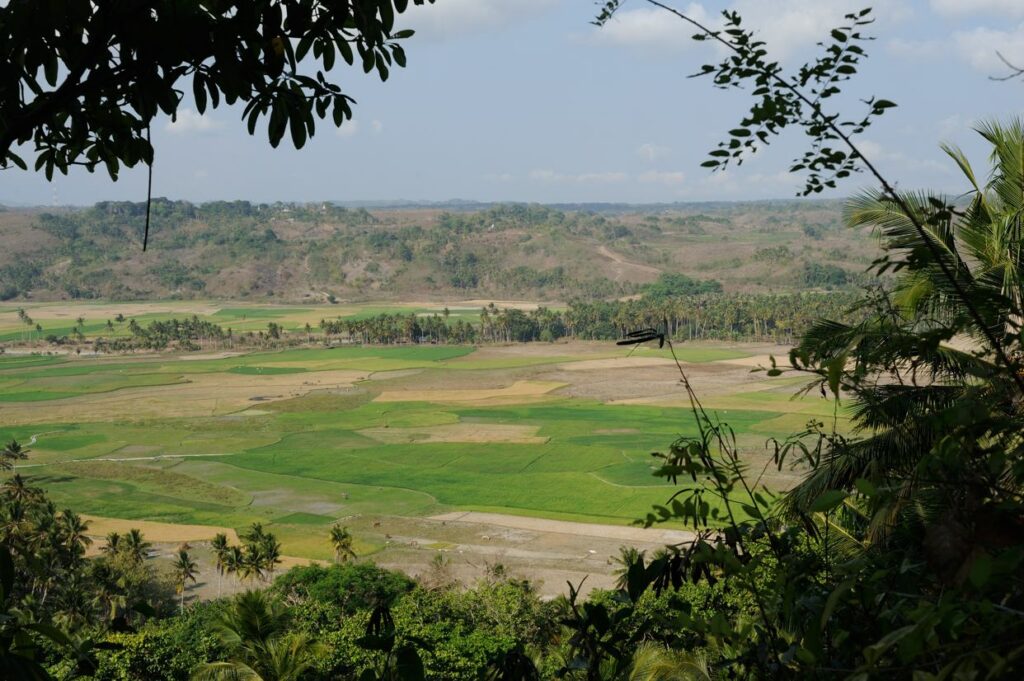
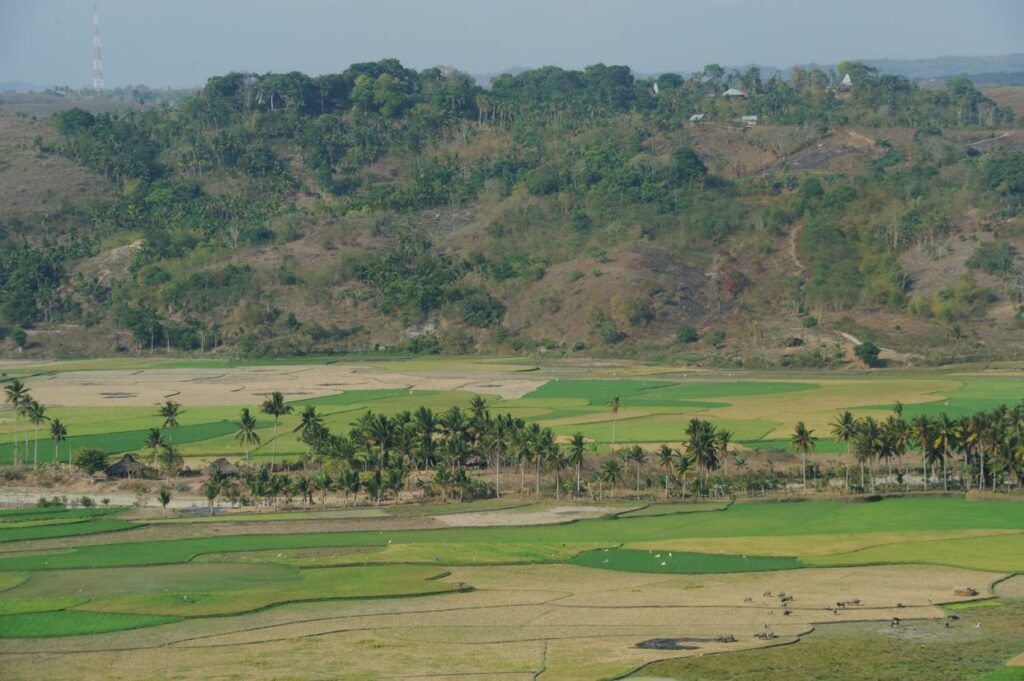
André Graff then decided to implement this technique in Waru Wora, a village of 33 households located on the west coast of the island, at the top of a hill which dominates the coastal plain from its 110 meters. Its inhabitants must then fetch their water, below, 1.3 km from the village. Captured water often stagnant, even rare in the dry season. Water with multiple uses and vector of many diseases, sometimes fatal.

He settled in the village and created there, in 2006, with nine natives, the “gorong-gorong cooperative” of Waru Wora. He buys molds and the materials necessary for the manufacture of “gorong-gorong” (5), questions the elders to know the places suitable for the construction of wells (6) and begins the work with his team (7).

In two years, 13 wells were built in this way until illness (8) stopped André Graff’s momentum in 2007. He then felt the need for a “break” and left in 2008 for six months in France. At the end of December, however, he returned to Indonesia to celebrate the arrival of the New Year with Munster cheese (!).
Well construction resumes. Fourteen new ones will see the light of day in 2009 and 2010. A total of 27 wells for a total cost of around 30,000 euros. A third of this amount was supported by the “department” of West Sumba (9), a third by various donations and the rest by André Graff personally.

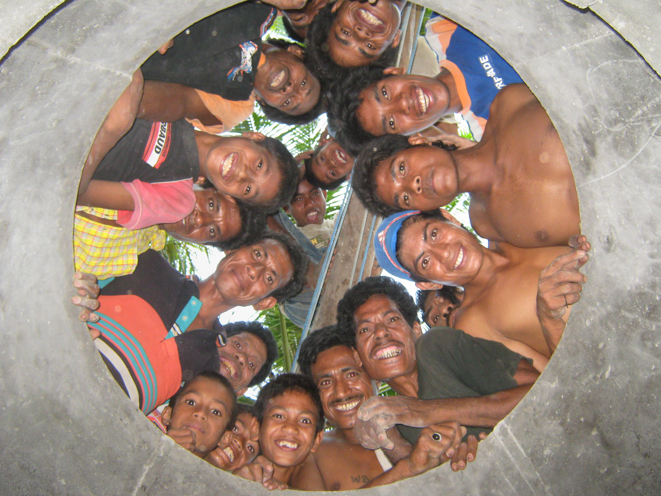
- How to raise the water in the village?
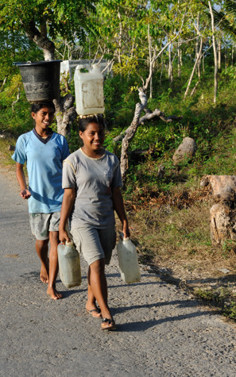
If the inhabitants of Waru Wora then have unpolluted water and at will all year round, there remains the drudgery of water, namely bringing it up from the valley to the village 1.3 km away with a drop of 110 meters. In reality, this question has been present in André Graff’s mind since 2006: “I was thinking then of a “trick” with pedals or – more seriously – wind power. But, at the beginning, the priority was the construction of wells”. In 2008, the issue of rising water levels became significant.
There is certainly the traditional solution of the generator. But André Graff rejects the idea of using this source of energy. Polluting, fragile due to numerous breakdowns due to the lack of maintenance and no longer really in tune with the times. In addition, it reinforces, in Indonesia, multiple corruptions in the diesel distribution system.
The solution then seemed obvious to André Graff: on an island where it happens that it does not rain two years in a row, it is the sun, supplier of free energy, which will exempt the inhabitants of the village from the drudgery of water (10).
Going from the intention to the beginning of realization will require nearly two years of work for André Graff: learning the operating mechanisms of solar energy, designing a global project, finding and meeting potential suppliers and going fishing for financing. .
- solar energy at the service of water
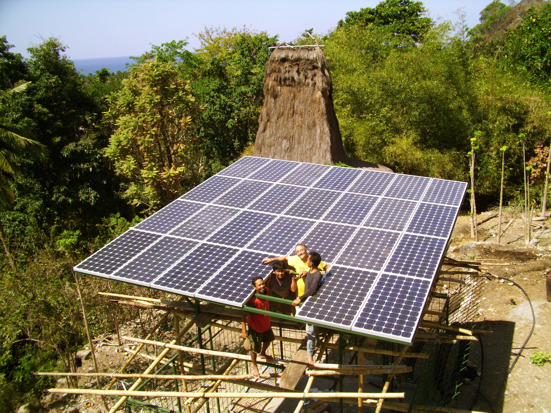

Electricity is provided by 28 solar panels representing an area of nearly six by seven meters. Each panel delivers 175 watts of power, or a total of nearly 5 kilowatts. The energy produced feeds a pump (11) which raises the water through a pipe – buried – four centimeters in diameter to 11 cisterns representing a storage capacity of 33,000 liters (12). From there, the water is distributed to 4 stations where the inhabitants come, at any time of the day, by turning a tap, to fetch water. “An important point”, emphasizes André Graff, “the system is designed to operate without batteries, the water being raised during the day, that is to say during sunny periods. Otherwise, the budget should have been larger and should have included the cost of the obsolescence of said batteries”.
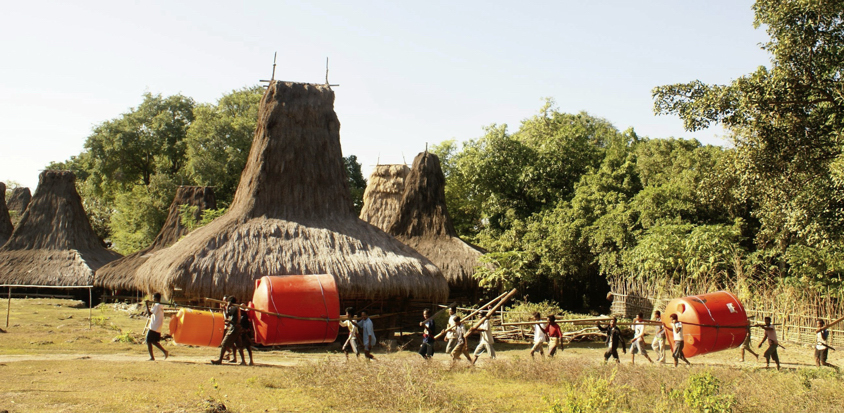
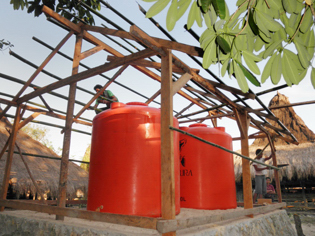
So what about the budget? : “it stands at 55,000 euros, the most important item being that of the solar panels. I received various financial aid (13), but I still had to pay 8,000 euros out of my own pocket to complete the budget “.
Maintenance costs being minimal and the solar panels having to operate in principle for 25 years, the investment, compared to that of a generator and the cost of its operation, must be profitable over a maximum period evaluated from six years to eight. years (14).
* Waru Wora, a Russian doll creation
Since August 2011, the 800 inhabitants of Waru Wora, for a contribution of approximately one euro per month and per household, have access to water for their domestic use all year round near their homes.
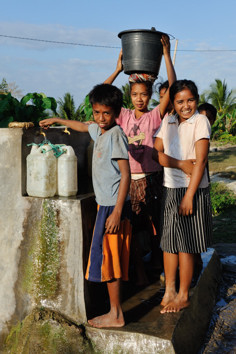
Related uses for this water have begun on the sanitary level (latrines) or are to be considered on the agricultural level. André Graff has developed a garden which, he hopes, could serve as a “model” so that the inhabitants of Wora Wora can thus diversify their diet (15).

And above all, he wants to improve and extend the existing in two directions:
– securing water quality in Waru Wora, in this village where it all began. On the one hand, by chlorinating, at the level of the pump, the water delivered and on the other hand by installing a filtration system for part of the water which will then be perfectly drinkable. The whole thing should cost around 7,500 euros.
– extend the existing water supply system in Waru Wora to 800 other inhabitants of the surroundings, which represents a budgetary cost of 20,000 euros (16).
* is this just the beginning?
When we travel the roads and tracks of Sumba, we discover many cisterns, plastic or concrete, often abandoned, in many localities. To what, one wonders then, do they correspond? It is because the need to supply water to the inhabitants of this deprived island has given rise, in recent years, to the launch of three other initiatives using funds either from the federal government, or from the World Bank, or from an NGO (organization non-governmental) American-Australian (17). “There have been, concomitantly with the work that I have been carrying out, since 2007, three other projects with the same objective as mine…so much money wasted for projects carried out by incompetent people”. And having probably been at the origin of numerous corruptions.
Because none of these initiatives has given concrete results: the hypothetical beneficiaries of these three projects are still waiting for the promised water to fill the installed cisterns!
Impressed by the effective results of the work carried out by André Graff, the “departmental” authorities of North Sumba decided to support the work carried out.
A second project, in the north of the island, started in September 2012. It should make water available to around a hundred families, ie 500 to 700 people (18).
Three other projects are currently under discussion (19). Nearly 10,000 people could then also have clean water close to their homes for their domestic uses, thanks to solar energy. Funding via the World Bank could concern the two largest projects. But the intervention of this financial institution requires the establishment of complex mechanisms that can only be resolved if the Indonesian public authorities are determined to support the projects.
Even if the future of these three other projects is, to date, uncertain, André Graff is not on the eve of his retirement despite often difficult material (20) and psychological conditions: “in this work, I learned, at the expense of my original naivety, that the “bastards” exist in all categories of populations, not only among the wealthy. I also learned that our cultures -Western and Sumbanese-, beyond the smiles meeting, are difficult to mix.. but I will never regret having devoted part of my life to the poorest.. and then, today, the meaning of my fight is first and foremost ecology” .
*
All in all, a titanic job that relies on the will of a single man (21), which certainly can make it fragile over time. But this problem is common to all projects of this type, whatever the object. There remains the question that every visitor to André Graff asks himself: where could he find the energy necessary to carry out a task of such magnitude?
The answer is to be sought from the person concerned. During the many friendly encounters I had with him in Sumba, I have, beyond appearances, met a man constantly in search of the Absolute, which leads him to go to the limits of human possibilities. . With the same determination and the risks that a mountaineer takes when climbing the highest peaks. Except that André Graff put this energy at the service of others..
Jean-Michel Gallet
(1) the island of Sumba, 220 km long. and wide from 40 to 70 km., has an area of 11,153 km2. It is located south of the Sunda Islands of which it is a part. It is the westernmost part of Micronesia
(2) daily water consumption is estimated at 150 liters for a French person. In the poorest countries, it ranges from 10 liters to 30 liters/day
(3) see roadmap 36 “funeral rites in Sumba” and slideshow 14. Admittedly, in the rare cities of the island, one finds some elements of “modernism”, but the employments which one meets there (administrations, trade, services) are, in the quasi-totality of the cases, implemented or occupied by Indonesians not originally from Sumba, such as the Chinese trading community. The natives, for the most part, stay in the countryside and live there while maintaining respect for traditions.
(4) waru means “earthen pot” in the local language. The quality of the earth makes it possible, in this village and in the surrounding villages, to manufacture various types of containers (pot, jar, cup, etc.) according to a method dating from the Neolithic period: the clod of earth, to which one added sand, is roughly excavated; let everything rest about two hours in the shade; then the craftsman “shapes” an object using a pebble and a bat: one hand, with the pebble, inside the container presses against the wall; the other hand, with the bat, taps on the outer wall to shape the object. What follows is “classic”: the container is dried in the sun, then placed in a fire of branches and straw. The result is an obviously unique container with slightly bumpy shapes
(5) unit cost of a gorong-gorong (a concrete cylinder): about 20 euros
(6) André Graff surrounds himself with dowsers to find the locations of water in a territory “which is a Gruyère”, but applies a rule: “before building a well, I always speak to the elders, those who have never worn sandals”
(7) constructing a well costs, depending on the size of the well, from 800 to 1,500 euros. This cost includes the materials needed for construction (cement, etc.) and labor. It does not include the cost of the moulds, however minimal
(8) malaria, dengue and typhus.
(9) the island of Sumba comprises 5 politico-administrative entities which are often translated into French by “department”
(10) in countries like Indonesia, where the sun is generally very present, any logical mind wonders why oil remains the main source of energy and why the use of solar energy is not more widespread. The answer lies essentially in the low cost of oil-based electricity produced in a producing country since the 1970s. Gasoline -more subsidized- is currently (summer 2012) sold for 40 cents/litre at the pump. And any plan to raise its price – Indonesia has been a net importer of oil since 2005 – immediately triggers waves of protest, bordering on rioting. The prospect of presidential elections in 2014 is obviously not likely to change this file much before that date.
(11) “German-built” specifies André Graff, “Chinese pumps, the only competitors, do not – yet – offer the same technological performance”
(12) i.e. 6 tanks of 5,000 liters and 3 tanks of 1,000 liters built in polyethylene. They are divided into 4 “water houses”, landscaped constructions integrated and sheltered in particular from the heat of the sun. They thus make it possible to have water that is always fresh and free of moss, unlike those installed by other operators in various villages of Sumba which deteriorate rapidly under the destructive effect of the natural elements (see point 15)
(13) aid from a water company -a subsidiary of the former Lyonnaise des Eaux-, a Dutch Rotary Club, an Indonesian pump manufacturing company and the “General Council” of West Sumba
(14) in this case, a generator of approximately 10KW and an electric pump would have been required, the whole representing an investment of around 5,000 euros. To pump 40 m3 of water per day and bring it up 110 meters in altitude, the generator must be run for around 4.5 hours per day, which requires around 3 liters of diesel fuel/hour. The overall operating cost, including maintenance costs, amounts to approximately 15 euros/day, or approximately 5,500 euros per year. Beyond a period of six to eight years, the “solar-water” couple will therefore save around 5,000 euros/year compared to a generator
(15) the inhabitants of Waru Wora feed on rice (the rice fields are in the valley), various roots or plants collected in the forest and some fruits, all supplemented, during festivals, by the consumption of meat, in particular pigs -which constantly roam between the houses-, even buffaloes
(16) this cost corresponds to 4/5 kilometers of buried pipes, about ten sheltered cisterns, 16 additional solar panels and a solar pump for a power of 2 kilowatts.
(17) the other three initiatives:
– a first project initiated in 2007 following a decision by the central authorities in Jakarta. The President of the Indonesian Republic having then wished that every Indonesian could have access to water, 25,000 euros were granted to each “desa” (a term that is often translated by “commune”, but which corresponds, in France , to the size of a canton) concerned. Result on the ground: badly galvanized pipes, therefore corroded; construction of a water distribution system with 7 cement tanks, too expensive and not maintained; and above all a well which turned out to be dry in a few days!
– a second project, launched in 2011, by the PMPM, a national public organization in charge of managing funds from the World Bank to carry out a water supply project entitled “mandi, cuci, cacus” (translation: se wash, be able to wash and have sanitary facilities). 35,000 euros have been made available to each “desa” although no one knows where the water could come from. Result: dozens of cisterns that pollute the landscape and are useless
– a third project, in 2011, financed by an NGO (non-governmental organization), the “Sumba Foundation”, itself financed by American and, in this case, Australian donors. This project consisted of providing villages with 2,200-litre tanks supplied from a well with an insufficient flow rate located near the rice fields and delivering polluted water from a diesel generator. It all worked for three months!
(18) the conditions, for this second achievement, being less complex than at Waru Wora, only two solar panels are necessary to produce energy of half a kilowatt/hour. The cost of the project is estimated at 5,000 euros financed half by the “General Council” of North Sumba and for the rest by the association “the wells of hope” -see point 21-
(19) the first of these projects would concern 3,000 people and would have an estimated cost of 55,000 euros. The second project, requiring the laying of an undersea cable to fetch water from a cave, would cost 35,000 euros and involve 2,000 to 3,000 people. The third project also from 2,000 to 3,000 people for an estimated cost of 15,000 euros
(20) André Graff does not receive any benefits from any social security or assistance, nor does he receive any salary or compensation for the work carried out. His only resources come from renting his house in Alsace
(21) However, a group of friends have been supporting André Graff’s work for several years. First in Indonesia where the support of the former Honorary Consul in office in Bali, Raphael Devianne, was decisive. In France, where an association was created at the end of 2011 – “les Puits de l’espoir” – see website: http://www.lespuitsdelespoir.fr
Photo credits: Jean-Michel Gallet and André Graff




